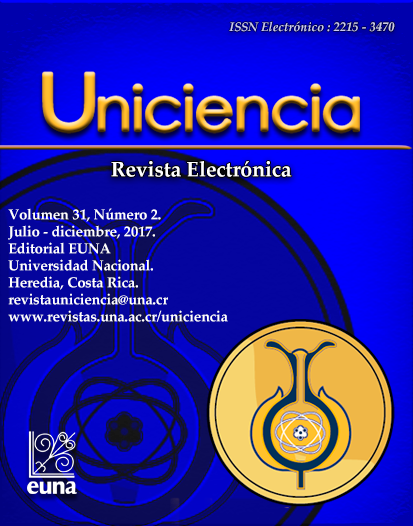Mathematical Modeling as a Didactic Strategy for Calculus Teaching
DOI:
https://doi.org/10.15359/ru.31-2.2Keywords:
Teaching strategy, Modeling, Calculus II, ICTsAbstract
Mathematical modeling is the activity that represents, manipulates, and communicates real-world objects with mathematical content; it also allows the simulation of complex processes, generates hypotheses, and suggests experiments or validation methods. Mathematical modeling is presented as a teaching strategy to simulate and interpret different real or academic life problems and situations by demonstrating different application conditions of university mathematical course contents. Specifically, in Calculus II, the strategy seeks to address the need to show and manipulate contents applications of improper integrals, series and Taylor polynomials, polar coordinates, and conic sections on specific problems with examples in biological sciences and engineering areas. This implementation respond to a paradigm that seeks innovation and continuous improvement of teaching and learning processes which is pertinent because of the existence of a platform incorporating ICTs (Information and Communications Technology) in Calculus II, and favoring the use of specialized software for the creation and manipulation of mathematical models.
References
Angel, J. & Bautista, G. (2001). Didáctica de las matemáticas en enseñanza superior: La utilización de software especializado. Recuperado de http://www.uoc.edu/web/esp/art/uoc/0107030/mates.html#bibliografia.
Belando, M. (2014). Formación permanente del profesorado. Algunos recursos TIC para la docencia universitaria. Revista Iberoamericana de Educación, 65(1), 1-11.
Blomhøj, M. (2004). Mathematical modelling - A theory for practice. International Perspectives on Learning and Teaching Mathematics, 1, 145-159.
Cascante, N. & Marín, P. (2012) La construcción de estrategias didácticas innovadoras en el contexto universitario: La experiencia desarrollada en el curso de Didáctica Universitaria. En Artolozaga, Cascante, D’Antoni y otros (Eds.), Didáctica Universitaria: Experiencias docentes en la Universidad de Costa Rica. SIEDIN. Recuperado de http://docenciauniversitaria.ucr.ac.cr/images/pdfs/publicaciones/publicaciones_en_linea/didacticauniversitaria.pdf
Castro, N. (2013). Efectos de la resolución de problemas como estrategia metodológica en la modelación y solución de problemas matemáticos que involucran ecuaciones de primero y de segundo grado (Trabajo de maestría). Universidad de la Salle.
Córdoba, F. (2011). La modelación en matemática educativa: Una práctica para el trabajo de aula en ingeniería (Tesis de maestría). Instituto Politécnico Nacional, México D.F.
Cruz, C. (2010). La enseñanza de la modelación matemática en ingeniería. Revista de la Facultad de Ingeniería, 25(3), 39-46.
Gatica, S. & Ares, O. (2012). La importancia de la visualización en el aprendizaje de conceptos matemáticos. Revista de Educación Mediática y TIC, 1 (2), 88-107.
Huincahue, J., & Mena-Lorca, J. (2014). Modelación matemática en la formación inicial de profesores. Pontificia Universidad Católica de Valparaíso, Chile.
King, RD., Garrett, S. M. & Coghill, G. M. (2005). On the use of qualitative reasoning to simulate and identify metabolic pathways. Bioinformatics, 21, 2017-2026. http://dx.doi.org/10.1093/bioinformatics/bti255
Molina-Mora, J. (2015). Experiencia basada en la triada TIC, enseñanza por proyectos y modelado para la enseñanza de sistemas de ecuaciones diferenciales. Revista Uniciencia, 29(2), 46-61.
Mora, R. (2012) Implementación de una estrategia didáctica utilizando modelado matemático por computadora para la comprensión de procesos biológicos. En Artolozaga, Cascante, D’Antoni y otros (Eds), Didáctica universitaria: Experiencias docentes en la Universidad de Costa Rica. SIEDIN. Recuperado de: http://docenciauniversitaria.ucr.ac.cr/images/pdfs/publicaciones/publicaciones_en_linea/didacticauniversitaria.pdf
Porras-Lizano, K., & Fonseca-Castro, J. (2015). Aplicación de actividades de modelización matemática en la educación secundaria costarricense. Revista Uniciencia, 29(1), 42-57. http://doi.org/10.15359/ru.29-1.3
Romero, S. (2011). La resolución de problemas como herramienta para la modelización matemática. Modelling in Science education and Learning, 4(5), 71-82. http://dx.doi.org/10.4995/msel.2011.3054
Trigueros, M. (2009). El uso de la modelación en la enseñanza de las matemáticas. Innovación Educativa, 9(46), 75-87.
Villalobos, J., Brenes, S. & Mora, S. (2012). Herramienta asistida por computadora para la enseñanza del álgebra relacional en bases de datos. Revista Uniciencia, 26, 179-195.
Villa-Ochoa, J. A. (2009). Modelación en educación matemática: Una mirada desde los lineamientos y estándares curriculares colombianos. Revista Virtual Universidad Católica del Norte, 27, 1-21.
Villa-Ochoa, J. A. (2013). Situaciones de modelación matemática: Algunas reflexiones para el aula de clase. I Congreso de educación matemática de América Central y el Caribe, República Dominicana.
Downloads
Published
Issue
Section
License
Authors who publish with this journal agree to the following terms:
1. Authors guarantee the journal the right to be the first publication of the work as licensed under a Creative Commons Attribution License that allows others to share the work with an acknowledgment of the work's authorship and initial publication in this journal.
2. Authors can set separate additional agreements for non-exclusive distribution of the version of the work published in the journal (eg, place it in an institutional repository or publish it in a book), with an acknowledgment of its initial publication in this journal.
3. The authors have declared to hold all permissions to use the resources they provided in the paper (images, tables, among others) and assume full responsibility for damages to third parties.
4. The opinions expressed in the paper are the exclusive responsibility of the authors and do not necessarily represent the opinion of the editors or the Universidad Nacional.
Uniciencia Journal and all its productions are under Creative Commons Atribución-NoComercial-SinDerivadas 4.0 Unported.
There is neither fee for access nor Article Processing Charge (APC)






